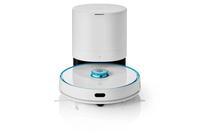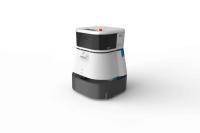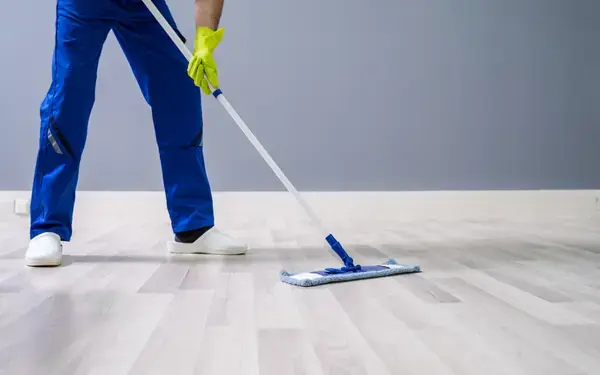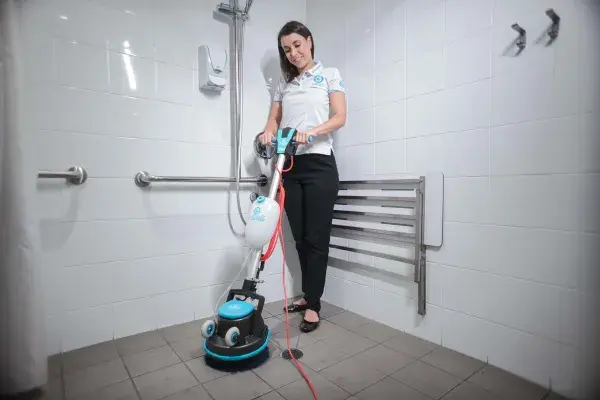You are reading: Are Co-Botic Machines Here to Stay? And Should We Use Them?
16 July 2025
6min read time
Brooke Payne
Are Co-Botic Machines Here to Stay? And Should We Use Them?
Share:

Key Insights
- Backed by a 30% annual growth in global professional service robot sales, co-botic cleaning has firmly moved beyond hype. Adoption is increasing across multiple industries—including healthcare, transport, and retail—due to its ability to address staffing shortages and deliver consistent cleaning performance.
- Unlike fully autonomous robots, co-botic machines are designed to work alongside humans, supporting repetitive and labor-intensive tasks while allowing cleaning staff to focus on high-priority areas. This hybrid approach enhances both efficiency and job satisfaction, rather than displacing workers.
- Co-botic cleaning delivers the best results when deployed in facilities with standardized cleaning needs and predictable layouts. Success metrics include improved cleaning consistency, reduced physical strain on staff, and enhanced scheduling flexibility. However, implementation should be tailored and gradual—starting with a pilot area to assess value before scaling.
The cleaning industry is experiencing a revolution. One of the most talked-about innovations is co-botic cleaning solutions.
But as with any new technology, questions arise: Is this just a passing trend, or is it here to stay?
With professional service robot sales surging globally, commercial property managers are increasingly looking to automation. They're addressing labor shortages and improving efficiency. Co-botic cleaning is proving itself to be much more than a passing fad.
In this article, we'll explore why co-botic cleaning represents a sustainable trend. We'llprovide data-backed insights into its growth. And we'll offer a practical framework for when it makes sense to adopt this technology.
Market Data Shows 30% Annual Growth In Robotic Sales —Not a Fad
At first glance, robots handling routine cleaning tasks might seem futuristic. Something that could fade as quickly as it arrived. However, the data tells a different story.
According to recent reports, global sales of professional service robots grew by 30% last year. This surge indicates growing demand for automation in commercial cleaning, not a fleeting gimmick.
Floor cleaning robots make up approximately 70% of the professional cleaning robot segment. They're fast becoming standard tools across industries.
Key takeaway: The numbers point to sustained market momentum, not temporary hype.
Book A DemoWhat Drives Robotic Sales?
The rise of co-botic cleaning aligns with broader automation trends across industries. Global labor shortages are impacting facility management, particularly in commercial real estate. More property managers are turning to automation to meet cleaning demands efficiently.
Cleaning robots are no longer experimental technologies. They're effective solutions that deliver measurable results.
Consider these market indicators:
- Sales jumped 30% globally last year
- The commercial cleaning robot market shows steady growth projections
- Increasing adoption rates across multiple sectors
- Technology maturity has reached practical implementation levels
Key takeaway: Automation in cleaning has moved from novelty to necessity for organisations needing consistent, high-quality results.
The Difference between Robotic vs. Co-Botic Machines
Before exploring benefits and limitations, it's important to understand the distinction between "robotic" and "co-botic" cleaning. While these terms are often used interchangeably, they represent different automation approaches.
Robotic Machines
Fully autonomous machines perform cleaning tasks independently with minimal human intervention. These robots are pre-programmed to clean specific areas. They rely heavily on sensors, algorithms, and programming to function.
Examples include robotic vacuum cleaners and floor scrubbers that operate independently once set up. While efficient, their ability to adapt to unexpected obstacles or complex environments can be limited without human input.
Co-Botic Machines
This represents a collaborative approach. Co-bots (collaborative robots) work alongside human staff, enhancing their capabilities and complementing their tasks.
Rather than replacing human cleaners, co-bots assist with repetitive or physically demanding tasks like floor cleaning. Human workers focus on more complex or high-priority areas. The goal isn't full automation but creating a human-robot partnership that improves overall cleaning efficiency.
Key takeaway: Co-botic systems offer more flexibility than fully autonomous robots by combining machine efficiency with human adaptability.
Take a read of our article on Manual to Mechanical Cleaning here .
Industries Already Using Co-Botic Machines
Co-botic cleaning has proven itself across several industries. It addresses challenges like labor shortages, inconsistent cleaning, and time inefficiencies.
The technology is currently deployed in:
- Commercial buildings: Maintaining large spaces with minimal human intervention
- Healthcare facilities: Ensuring consistent, high-quality cleaning where hygiene is paramount
- Airports and transport hubs: Handling high-volume cleaning needs efficiently
- Retail and hospitality: Providing effective floor care in large public spaces requiring around-the-clock cleaning
Some facilities use co-botic cleaning for daily tasks, freeing human workers to focus on complex or sensitive duties. In hospitals, robots clean floors in common areas, reducing staff time on these tasks while maintaining high cleanliness standards.
Early adopters report reduced operational costs, improved cleaning consistency, and greater satisfaction from both employees and customers.
Key takeaway: The technology is making significant impact in sectors where labor efficiency and cleanliness are critical.
Limitations of Co-Botic Solutions
While co-botic cleaning offers benefits, it's not without limitations. You should understand where these solutions work best and where they may fall short.
Co-botic cleaning may not be ideal for every facility or scenario:
Complex or Specialised Cleaning Needs
Areas requiring high attention to detail may pose challenges. Intricate cleaning or disinfection of sensitive equipment often requires human expertise that robots can't match.
Initial Investment Considerations
The upfront investment can be significant. While robots offer long-term savings by reducing labor costs, you need to factor in maintenance and repair expenses.
Environmental Flexibility
Some robots struggle in environments with unpredictable layouts or obstacles. Specific cleaning demands that require human oversight can limit robotic effectiveness.
Key takeaway: Co-botic cleaning works best in environments with standardized cleaning requirements and predictable layouts.
Performance Metrics: Measuring Co-Botic Success
Successful co-botic implementation should deliver measurable improvements across several areas.
Cleaning Quality Improvements
Most facilities report more consistent cleaning standards. Robotic systems maintain uniform cleaning patterns. Human error in routine tasks decreases significantly.
Staff Satisfaction Impacts
Cleaning staff often report reduced physical strain. Workers can focus on more engaging, skilled tasks. Job satisfaction typically improves when repetitive work is automated.
Operational Efficiency Gains
Coverage areas increase without proportional staff increases. Cleaning can occur during off-hours more easily. Facilities often achieve better scheduling flexibility.
Key takeaway: Track both quantitative metrics (coverage, time) and qualitative measures (staff satisfaction, cleaning consistency) to assess success.
Best Co-Botic Machine Options:
The co-botic cleaning market has seen remarkable growth, offering a range of floor cleaning solutions that cater to different facility sizes and cleaning needs. These advanced technologies not only help businesses improve cleaning efficiency but also enable staff to focus on more specialised or complex tasks by automating repetitive floor cleaning work.
Today’s co-botic floor cleaning solutions are second- and third-generation technologies that have evolved to become highly reliable. These systems now integrate seamlessly with existing cleaning operations, making it easier for businesses to adopt them without disruption. With improved performance and reduced operational hurdles, floor cleaning robots have become more dependable and accessible than ever.
Floor Cleaning Robot Types
- Robotic Vacuum Cleaners: The i-team ANZ Co-Botic 1700 robotic vacuum cleaner is an excellent choice for businesses looking to automate floor cleaning in large, open spaces. This model can autonomously clean expansive areas, such as hallways, offices, and lobbies, allowing your staff to focus on more detailed or high-priority tasks. It’s ideal for routine cleaning and provides consistent results without the need for constant human oversight.
- Robotic Floor Scrubbers: The i-team ANZ Co-Botic 45 robotic floor scrubber is perfect for environments that require regular, deep cleaning. Whether it's a warehouse, shopping mall, or school, this scrubber autonomously cleans floors while providing high-quality results. With its advanced cleaning mechanisms, it ensures that floors are left spotless and dry, ready for foot traffic almost immediately. The Co-Botic 45 is especially useful in high-traffic areas where cleaning demands are constant.
- Hybrid Floor Cleaning Solutions: The i-walk, (while still a co-botic) can be described as a hybrid solution that gives facility managers more control when needed. It can autonomously clean large areas and then, with a quick switch, allows the operator to manually control the i-mop for detailed cleaning in high-traffic zones or smaller spaces that need extra attention. This flexibility makes the i-walk ideal for environments where both automated and manual cleaning are required, such as in large commercial spaces or facilities with mixed floor types.
Key takeaway: Focus on proven floor cleaning solutions first, then expand to other applications as your team gains experience.
Should I Buy a Robotic Cleaner?
When should you consider adopting co-botic cleaning solutions? Use this framework to guide your decision-making process.
Assess Your Facility's Fit
- Do you struggle with staffing for routine cleaning tasks?
- Are you experiencing high turnover in cleaning positions?
- Would consistent cleaning coverage improve your operations?
- Would labor cost savings justify the initial investment?
- Do you need to improve cleaning consistency?
- Could a co-botic solution help speed up the cleaning process, allowing your cleaning staff to focus on more complex tasks?
- Would off-hours cleaning capability benefit your operations?
- Are sustainability goals important to your organisation?
- Are you trying to increase staff retention?
If you answered "yes" to most questions in each category, co-botic cleaning likely makes sense for your facility. Start with a pilot program in one area to test effectiveness before full deployment.
Key takeaway: Co-botic cleaning works best when facility characteristics align with technology capabilities and your organization is ready for the implementation process.
The Future in Co-Botic Cleaning
The co-botic cleaning industry is positioned for continued growth and innovation.
As artificial intelligence and machine learning improve, co-botic cleaners will become more efficient and flexible. Costs will continue decreasing as technology matures.
We can expect to see:
- Increased task automation: Robots handling more complex cleaning functions
- Smarter AI systems: Machines adapting to different environments and optimizing routes autonomously
- Broader accessibility: Lower costs making solutions available to mid-sized facilities
- Enhanced integration: Better coordination with existing facility management systems
- By 2028, commercial cleaning robots will likely become standard facility management tools rather than innovative exceptions.
Key takeaway: Early adoption provides competitive advantages, but the technology will become more accessible and capable over time.
Conclusion: Making an Informed Decision About Co-Botic Cleaning
Co-botic cleaning solutions are undeniably here to stay. They offer significant benefits in labor efficiency, consistency, and operational flexibility. However, they're not a one-size-fits-all solution.
Success depends on matching technology capabilities with your facility's specific needs. Consider your space size, cleaning requirements, staffing challenges, and budget constraints.
Co-botic cleaning represents more than just a trend. It's a growing segment improving operational efficiencies across commercial properties. The key is understanding when and how to implement these solutions effectively.
If you're considering automation, start by evaluating your facility against the decision framework provided. Assess how these technologies can complement your existing staff rather than simply replacing them.
For facilities that fit the co-botic profile, now is an excellent time to explore how this technology can drive efficiencies and position you for success in the evolving cleaning industry.
The future of commercial cleaning combines human expertise with technological efficiency. By taking a thoughtful approach to co-botic adoption, you can achieve better results while creating a more sustainable and effective cleaning operation.
To take a look at the i-team ANZ co-botic and robotic solutions , click here.
Products Featured Inside this Article
Media and Insights
Join the movement that's changing what clean means.
Be part of a cleaner world. Get a live demo at a time that suits you.
Book a Demo











